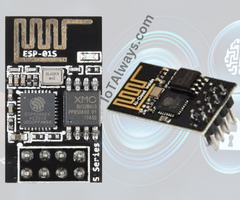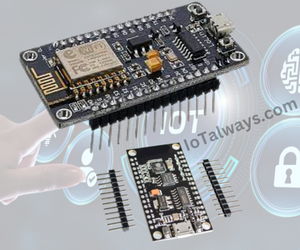ESP8266
The NodeMCU (ESP8266) is a low-cost Wi-Fi microcontroller board that is becoming increasingly popular among hobbyists, makers, and IoT enthusiasts. This article will explore the features and capabilities of the NodeMCU and demonstrate how you can use it to bring your IoT projects to life.
Introduction to NodeMCU
The NodeMCU is a development board that is based on the ESP8266 microcontroller. It was designed to be a low-cost and simple solution for connecting devices to the internet. The NodeMCU features a micro-USB port, which makes it easy to program and power the board. It also features a microSD card slot, which can be used for data storage and retrieval.
ESP01

It is a small module based on the ESP8266 chip and has a small form factor.The ESP01 module has two GPIO pins, a serial interface, and an on-board antenna, and it can be programmed using the Arduino Integrated Development Environment (IDE).
NodeMCU

NodeMCU is a microcontroller development board with ESp12E module with large number of digital I/Os and one analog I/O, and direct USB programming feature.
Features and Capabilities of NodeMCU
One of the key features of the NodeMCU is its built-in Wi-Fi capabilities. The ESP8266 microcontroller has a built-in 802.11 b/g/n Wi-Fi module, which means that it can easily connect to wireless networks. This makes it ideal for IoT applications, as it can be used to send and receive data over the internet.
The NodeMCU also has a number of I/O pins, which can be used to connect to sensors, actuators, and other devices. These pins can be used to control and monitor devices, as well as to receive data from sensors. The board can be programmed using the Arduino IDE, which makes it easy for makers to get started with their projects.
Applications of NodeMCU
One of the most popular applications of the NodeMCU is home automation. The board can be used to control and monitor lighting, temperature, and other aspects of the home. For example, it can be used to control smart lights, which can be turned on and off using a smartphone app. The NodeMCU can also be used for environmental monitoring. For example, it can be used to monitor temperature, humidity, and air quality. This information can be used to control HVAC systems and to improve indoor air quality. Another popular application of the NodeMCU is in the field of security. The board can be used to build a home security system, which can detect and alert users to any intrusions. This can be done using sensors, such as motion detectors, and cameras.
Conclusion
The NodeMCU (ESP8266) is a versatile and low-cost Wi-Fi microcontroller board that is ideal for a wide range of IoT applications. With its built-in Wi-Fi capabilities and I/O pins, the NodeMCU can be used to control and monitor devices, as well as to receive data from sensors. Whether you are building a home automation system, an environmental monitoring system, or a security system, the NodeMCU is a great choice for your next IoT project.